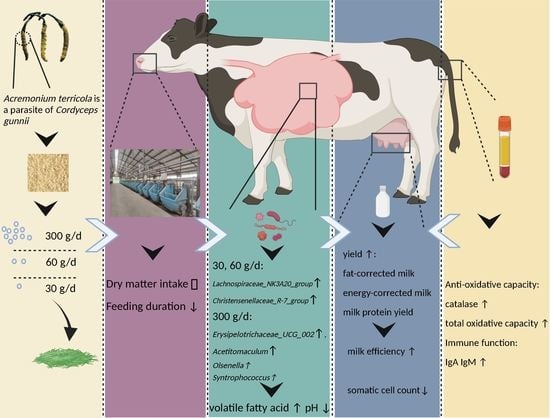Acremonium terricola Culture’s Dose–Response Effects on Lactational Performance, Antioxidant Capacity, and Ruminal Characteristics in Holstein Dairy Cows
Abstract
1. Introduction
2. Materials and Methods
2.1. Animals and Treatments
2.2. Sampling and Analysis
2.3. Statistical Analysis
3. Results
3.1. Feeding Behavior
3.2. Milk Performance
3.3. Serum Variables
3.4. Rumen Fermentation Parameters
3.5. Diversity of Rumen Microbiota
3.6. Microbial Profiles of Rumen Microbiota
3.7. Changes in the Rumen Bacterial Composition with Acremonium terricola Culture Supplementation
4. Discussion
5. Conclusions
Supplementary Materials
Author Contributions
Funding
Institutional Review Board Statement
Informed Consent Statement
Data Availability Statement
Conflicts of Interest
References
- Fiore, E.; Arfuso, F.; Gianesella, M.; Vecchio, D.; Morgante, M.; Mazzotta, E.; Badon, T.; Rossi, P.; Bedin, S.; Piccione, G. Metabolic and hormonal adaptation in Bubalus bubalis around calving and early lactation. PLoS ONE 2018, 13, e0193803. [Google Scholar] [CrossRef]
- Avondo, M.; Pagano, R.I.; Guastella, A.M.; Criscione, A.; Di Gloria, M.; Valenti, B.; Piccione, G.; Pennisi, P. Diet selection and milk production and composition in Girgentana goats with different alpha s1-casein genotype. J. Dairy Res. 2009, 76, 202–209. [Google Scholar] [CrossRef]
- Armato, L.; Gianesella, M.; Morgante, M.; Fiore, E.; Rizzo, M.; Giudice, E.; Piccione, G. Rumen volatile fatty acids× dietary supplementation with live yeast and yeast cell wall in feedlot beef cattle. Acta Agric. Scand. A—Anim. Sci. 2016, 66, 119–124. [Google Scholar] [CrossRef]
- Monteverde, V.; Congiu, F.; Vazzana, I.; Dara, S.; Di Pietro, S.; Piccione, G. Serum lipid profile modification related to polyunsaturated fatty acid supplementation in thoroughbred horses. J. Appl. Anim. Res. 2017, 45, 615–618. [Google Scholar] [CrossRef]
- Đuričić, D.; Ljubić, B.B.; Vince, S.; Turk, R.; Valpotić, H.; Žaja, I.Ž.; Maćešić, N.; Benić, M.; Getz, I.; Samardžija, M. Effects of dietary clinoptilolite supplementation on β-hydroxybutirate serum level and milk fat to protein ratio during early lactation in holstein-friesian cows. Microporous Mesoporous Mater. 2020, 292, 109766. [Google Scholar] [CrossRef]
- Folnožić, I.; Samardžija, M.; Đuričić, D.; Vince, S.; Perkov, S.; Jelušić, S.; Valpotić, H.; Ljubić, B.B.; Lojkić, M.; Gračner, D. Effects of in-feed clinoptilolite treatment on serum metabolic and antioxidative biomarkers and acute phase response in dairy cows during pregnancy and early lactation. Res. Vet. Sci. 2019, 127, 57–64. [Google Scholar] [CrossRef] [PubMed]
- Folnožić, I.; Đuričić, D.; Žaja, I.Ž.; Vince, S.; Perkov, S.; Turk, R.; Valpotić, H.; Gračner, D.; Maćešić, N.; Lojkić, M. The influence of dietary clinoptilolite on blood serum mineral profile in dairy cows. Vet. Arh. 2019, 89, 447–462. [Google Scholar] [CrossRef]
- Đuričić, D.; Sukalić, T.; Marković, F.; Kočila, P.; Žura Žaja, I.; Menčik, S.; Dobranić, T.; Benić, M.; Samardžija, M. Effects of dietary vibroactivated clinoptilolite supplementation on the intramammary microbiological findings in dairy cows. Animals 2020, 10, 202. [Google Scholar] [CrossRef] [PubMed]
- Ashraf, S.A.; Elkhalifa, A.E.O.; Siddiqui, A.J.; Patel, M.; Awadelkareem, A.M.; Snoussi, M.; Ashraf, M.S.; Adnan, M.; Hadi, S. Cordycepin for Health and Wellbeing: A Potent Bioactive Metabolite of an Entomopathogenic Cordyceps Medicinal Fungus and Its Nutraceutical and Therapeutic Potential. Molecules 2020, 25, 2735. [Google Scholar] [CrossRef] [PubMed]
- Chuang, W.Y.; Hsieh, Y.C.; Lee, T.-T. The Effects of Fungal Feed Additives in Animals: A Review. Animals 2020, 10, 805. [Google Scholar] [CrossRef]
- Das, G.; Shin, H.-S.; Leyva-Gómez, G.; Prado-Audelo, M.L.D.; Cortes, H.; Singh, Y.D.; Panda, M.K.; Mishra, A.P.; Nigam, M.; Saklani, S.; et al. Cordyceps spp.: A Review on Its Immune-Stimulatory and Other Biological Potentials. Front. Pharmacol. 2021, 11, 602364. [Google Scholar] [CrossRef] [PubMed]
- Li, R.; Tang, N.; Jia, X.; Xu, Y.; Cheng, Y. Antidiabetic activity of galactomannan from Chinese Sesbania cannabina and its correlation of regulating intestinal microbiota. J. Funct. Foods 2021, 83, 104530. [Google Scholar] [CrossRef]
- Cho, H.J.; Cho, J.Y.; Rhee, M.H.; Park, H.J. Cordycepin (3′-deoxyadenosine) inhibits human platelet aggregation in a cyclic AMP- and cyclic GMP-dependent manner. Eur. J. Pharmacol. 2007, 558, 43–51. [Google Scholar] [CrossRef]
- Kang, N.; Lee, H.-H.; Park, I.; Seo, Y.-S. Development of High Cordycepin-Producing Cordyceps militaris Strains. Mycobiology 2017, 45, 31–38. [Google Scholar] [CrossRef]
- Raethong, N.; Wang, H.; Nielsen, J.; Vongsangnak, W. Optimizing cultivation of Cordyceps militaris for fast growth and cordycepin overproduction using rational design of synthetic media. Comput. Struct. Biotechnol. J. 2019, 18, 1–8. [Google Scholar] [CrossRef]
- Li, Y.; Jiang, X.; Xu, H.; Lv, J.; Zhang, G.; Dou, X.; Zhang, Y.; Li, X. Acremonium terricola culture plays anti-inflammatory and antioxidant roles by modulating MAPK signaling pathways in rats with lipopolysaccharide-induced mastitis. Food Nutr. Res. 2020, 64. [Google Scholar] [CrossRef]
- Li, Y.; Wang, Y.-z.; Ding, X.; Zhang, Y.-g.; Xue, S.-c.; Lin, C.; Xu, W.-b.; Dou, X.-J.; Zhang, L.-Y. Effects of Acremonium terricola culture on growth performance, antioxidant status and immune functions in weaned calves. Livest Sci. 2016, 193, 66–70. [Google Scholar] [CrossRef]
- Li, Y.; Sun, Y.-K.; Li, X.; Zhang, G.-N.; Xin, H.-S.; Xu, H.-J.; Zhang, L.-Y.; Li, X.-X.; Zhang, Y.-G. Effects of Acremonium terricola culture on performance, milk composition, rumen fermentation and immune functions in dairy cows. Anim. Feed Sci. Technol. 2018, 240, 40–51. [Google Scholar] [CrossRef]
- Li, Y.; Wang, Y.-Z.; Zhang, G.-N.; Zhang, X.-Y.; Lin, C.; Li, X.-X.; Zhang, Y.-G. Effects of Acremonium terricola culture supplementation on apparent digestibility, rumen fermentation, and blood parameters in dairy cows. Anim. Feed Sci. Technol. 2017, 230, 13–22. [Google Scholar] [CrossRef]
- Bradford, B.J.; Yuan, K.; Farney, J.K.; Mamedova, L.K.; Carpenter, A.J. Invited review: Inflammation during the transition to lactation: New adventures with an old flame. J. Dairy Sci. 2015, 98, 6631–6650. [Google Scholar] [CrossRef]
- Dobos, A.; Fodor, I.; Kreizinger, Z.; Makrai, L.; Dénes, B.; Kiss, I.; Đuričić, D.; Kovačić, M.; Szeredi, L. Infertility in dairy cows–Possible bacterial and viral causes. Vet. Stanica 2022, 53, 35–43. [Google Scholar] [CrossRef]
- Đuričić, D.; Vince, S.; Lojkić, M.; Jelušić, S.; Turk, R.; Valpotić, H.; Gračner, D.; Maćešić, N.; Folnožić, I.; Šostar, Z. Effects of dietary clinoptilolite on reproductive performance, serum progesterone and insulin-like growth factor-1 concentrations in dairy cows during pregnancy and lactation. Pol. J. Vet. Sci. 2020, 23, 69–75. [Google Scholar] [CrossRef] [PubMed]
- Wang, Y.-Z.; Li, Y.; Xu, Q.-B.; Zhang, X.-Y.; Zhang, G.-N.; Lin, C.; Zhang, Y.-G. Effects of Acremonium terricola culture on production performance, antioxidant status, and blood biochemistry in transition dairy cows. Anim. Feed Sci. Technol. 2019, 256, 114261. [Google Scholar] [CrossRef]
- Winarti, S.; Prasetyo, A. The Consumption of Galactomannan Effervescent Drinks made from Coconut Pulp Waste and Colonic Microbiota in Wistar Rats. Int. J. Probiotics Prebiotics 2020, 15, 52–56. [Google Scholar] [CrossRef]
- Majeed, M.; Majeed, S.; Nagabhushanam, K.; Arumugam, S.; Natarajan, S.; Beede, K.; Ali, F. Galactomannan from Trigonella foenum-graecum L. seed: Prebiotic application and its fermentation by the probiotic Bacillus coagulans strain MTCC 5856. Food Sci. Nutr. 2018, 6, 666–673. [Google Scholar] [CrossRef] [PubMed]
- Newbold, C.J.; McIntosh, F.M.; Wallace, R.J. Changes in the microbial population of a rumen-simulating fermenter in response to yeast culture. Can. J. Anim. Sci. 1998, 78, 241–244. [Google Scholar] [CrossRef]
- Malmuthuge, N.; Guan, L.L. Understanding host-microbial interactions in rumen: Searching the best opportunity for microbiota manipulation. J. Anim. Sci. Biotechnol. 2017, 8, 8. [Google Scholar] [CrossRef]
- Tuli, H.S.; Sandhu, S.S.; Sharma, A.K. Pharmacological and therapeutic potential of Cordyceps with special reference to Cordycepin. 3 Biotech 2014, 4, 1–12. [Google Scholar] [CrossRef]
- Shashidhar, M.G.; Giridhar, P.; Udaya Sankar, K.; Manohar, B. Bioactive principles from Cordyceps sinensis: A potent food supplement—A review. J. Funct. Foods 2013, 5, 1013–1030. [Google Scholar] [CrossRef]
- Yu, X.; Mao, Y.; Shergis, J.L.; Coyle, M.E.; Wu, L.; Chen, Y.; Zhang, A.L.; Lin, L.; Xue, C.C.; Xu, Y. Effectiveness and Safety of Oral Cordyceps sinensis on Stable COPD of GOLD Stages 2-3: Systematic Review and Meta-Analysis. Evid. Based Complement. Altern. Med. 2019, 2019, 4903671. [Google Scholar] [CrossRef] [PubMed]
- Rodman, L.E.; Farnell, D.R.; Coyne, J.M.; Allan, P.W.; Hill, D.L.; Duncan, K.L.K.; Tomaszewski, J.E.; Smith, A.C.; Page, J.G. Toxicity of Cordycepin in Combination with the Adenosine Deaminase Inhibitor 2′-Deoxycoformycin in Beagle Dogs. Toxicol. Appl. Pharmacol. 1997, 147, 39–45. [Google Scholar] [CrossRef] [PubMed]
- Wang, C.; Zhao, F.; Liu, J.; Liu, H. Dipeptide (Methionyl-Methionine) Transport and Its Effect on β-Casein Synthesis in Bovine Mammary Epithelial Cells. Cell. Physiol. Biochem. 2018, 49, 479–488. [Google Scholar] [CrossRef]
- National Research Council. Nutrient Requirements of Dairy Cattle; National Academy Press: Washington, DC, USA, 2001. [Google Scholar]
- Association of Official Analytical Chemists. Official Methods of Analysis; AOAC International: Gaithersburg, MD, USA, 2000. [Google Scholar]
- Van Soest, P.J.; Robertson, J.B.; Lewis, B.A. Methods for dietary fiber, neutral detergent fiber, and nonstarch polysaccharides in relation to animal nutrition. J. Dairy Sci. 1991, 74, 3583–3597. [Google Scholar] [CrossRef]
- Chang, C.Y.; Lue, M.Y.; Pan, T.M. Determination of Adenosine, Cordycepin and Ergosterol Contents in Cultivated Antrodia camphorata by HPLC Method. J. Food Drug Anal. 2005, 13, 338–342. [Google Scholar] [CrossRef]
- Kong, F.; Lu, N.; Liu, Y.; Zhang, S.; Li, S. Aspergillus oryzae and Aspergillus niger Co-Cultivation Extract Affects In Vitro Degradation, Fermentation Characteristics, and Bacterial Composition in a Diet-Specific Manner. Animals 2021, 11, 1248. [Google Scholar] [CrossRef] [PubMed]
- Kong, F.; Gao, Y.; Tang, M.; Fu, T.; Diao, Q.; Bi, Y.; Tu, Y. Effects of dietary rumen–protected Lys levels on rumen fermentation and bacterial community composition in Holstein heifers. Appl. Microbiol. Biotechnol. 2020, 104, 6623–6634. [Google Scholar] [CrossRef] [PubMed]
- Chen, S.; Zhou, Y.; Chen, Y.; Gu, J. fastp: An ultra-fast all-in-one FASTQ preprocessor. Bioinformatics 2018, 34, i884–i890. [Google Scholar] [CrossRef]
- Magoč, T.; Salzberg, S.L. FLASH: Fast length adjustment of short reads to improve genome assemblies. Bioinformatics 2011, 27, 2957–2963. [Google Scholar] [CrossRef]
- Huang, S.; Ji, S.; Wang, F.; Huang, J.; Alugongo, G.M.; Li, S. Correction to: Dynamic changes of the fecal bacterial community in dairy cows during early lactation. AMB Express 2021, 11, 40. [Google Scholar] [CrossRef]
- Edgar, R.C. UPARSE: Highly accurate OTU sequences from microbial amplicon reads. Nat. Methods 2013, 10, 996–998. [Google Scholar] [CrossRef]
- Wang, Q.; Garrity, G.M.; Tiedje, J.M.; Cole, J.R. Naive Bayesian classifier for rapid assignment of rRNA sequences into the new bacterial taxonomy. Appl. Environ. Microbiol. 2007, 73, 5261–5267. [Google Scholar] [CrossRef]
- Pruesse, E.; Quast, C.; Knittel, K.; Fuchs, B.M.; Ludwig, W.; Peplies, J.; Glöckner, F.O. SILVA: A comprehensive online resource for quality checked and aligned ribosomal RNA sequence data compatible with ARB. Nucleic Acids Res. 2007, 35, 7188–7196. [Google Scholar] [CrossRef] [PubMed]
- Caporaso, J.G.; Kuczynski, J.; Stombaugh, J.; Bittinger, K.; Bushman, F.D.; Costello, E.K.; Fierer, N.; Peña, A.G.; Goodrich, J.K.; Gordon, J.I.; et al. QIIME allows analysis of high-throughput community sequencing data. Nat. Methods 2010, 7, 335–336. [Google Scholar] [CrossRef] [PubMed]
- Boontiam, W.; Wachirapakorn, C.; Wattanachai, S. Growth performance and hematological changes in growing pigs treated with Cordyceps militaris spent mushroom substrate. Vet. World 2019, 13, 768–773. [Google Scholar] [CrossRef]
- Chanjula, P.; Cherdthong, A. Effects of spent mushroom Cordyceps militaris supplementation on apparent digestibility, rumen fermentation, and blood metabolite parameters of goats. J. Anim. Sci. 2018, 96, 1150–1158. [Google Scholar] [CrossRef]
- Kaufman, E.I.; Asselstine, V.H.; LeBlanc, S.J.; Duffield, T.F.; DeVries, T.J. Association of rumination time and health status with milk yield and composition in early-lactation dairy cows. J. Dairy Sci. 2018, 101, 462–471. [Google Scholar] [CrossRef] [PubMed]
- Galindo, F.; Broom, D.M. The relationships between social behaviour of dairy cows and the occurrence of lameness in three herds. Res. Vet. Sci. 2000, 69, 75–79. [Google Scholar] [CrossRef]
- Costa, A.; Lopez-Villalobos, N.; Sneddon, N.W.; Shalloo, L.; Franzoi, M.; De Marchi, M.; Penasa, M. Invited review: Milk lactose—Current status and future challenges in dairy cattle. J. Dairy Sci. 2019, 102, 5883–5898. [Google Scholar] [CrossRef]
- Costa, A.; Neglia, G.; Campanile, G.; De Marchi, M. Milk somatic cell count and its relationship with milk yield and quality traits in Italian water buffaloes. J. Dairy Sci. 2020, 103, 5485–5494. [Google Scholar] [CrossRef]
- Rainard, P.; Foucras, G.; Boichard, D.; Rupp, R. Invited review: Low milk somatic cell count and susceptibility to mastitis. J. Dairy Sci. 2018, 101, 6703–6714. [Google Scholar] [CrossRef]
- Boontiam, W.; Wachirapakorn, C.; Phaengphairee, P.; Wattanachai, S. Effect of Spent Mushroom (Cordyceps militaris) on Growth Performance, Immunity, and Intestinal Microflora in Weaning Pigs. Animals 2020, 10, 2360. [Google Scholar] [CrossRef] [PubMed]
- Barros, T.; Quaassdorff, M.A.; Aguerre, M.J.; Colmenero, J.J.O.; Bertics, S.J.; Crump, P.M.; Wattiaux, M.A. Effects of dietary crude protein concentration on late-lactation dairy cow performance and indicators of nitrogen utilization. J. Dairy Sci. 2017, 100, 5434–5448. [Google Scholar] [CrossRef]
- Schwab, C.G.; Broderick, G.A. A 100-Year Review: Protein and amino acid nutrition in dairy cows. J. Dairy Sci. 2017, 100, 10094–10112. [Google Scholar] [CrossRef]
- Moharrery, A. Investigation of different levels of RDP in the rations of lactating cows and their effects on MUN, BUN and urinary N excretion. Ital. J. Anim. Sci. 2010, 3, 157–165. [Google Scholar] [CrossRef][Green Version]
- Morris, D.L.; Kononoff, P.J. Effects of rumen-protected lysine and histidine on milk production and energy and nitrogen utilization in diets containing hydrolyzed feather meal fed to lactating Jersey cows. J. Dairy Sci. 2020, 103, 7110–7123. [Google Scholar] [CrossRef] [PubMed]
- Fehlberg, L.K.; Guadagnin, A.R.; Thomas, B.L.; Sugimoto, Y.; Shinzato, I.; Cardoso, F.C. Feeding rumen-protected lysine prepartum increases energy-corrected milk and milk component yields in Holstein cows during early lactation. J. Dairy Sci. 2020, 103, 11386–11400. [Google Scholar] [CrossRef]
- Chen, B.; Sun, Y.; Luo, F.; Wang, C. Bioactive Metabolites and Potential Mycotoxins Produced by Cordyceps Fungi: A Review of Safety. Toxins 2020, 12, 410. [Google Scholar] [CrossRef] [PubMed]
- Ramos, S.C.; Jeong, C.D.; Mamuad, L.L.; Kim, S.H.; Kang, S.H.; Kim, E.T.; Cho, Y.I.; Lee, S.S.; Lee, S.S. Diet Transition from High-Forage to High-Concentrate Alters Rumen Bacterial Community Composition, Epithelial Transcriptomes and Ruminal Fermentation Parameters in Dairy Cows. Animals 2021, 11, 838. [Google Scholar] [CrossRef]
- Shabat, S.K.; Sasson, G.; Doron-Faigenboim, A.; Durman, T.; Yaacoby, S.; Berg Miller, M.E.; White, B.A.; Shterzer, N.; Mizrahi, I. Specific microbiome-dependent mechanisms underlie the energy harvest efficiency of ruminants. ISME J. 2016, 10, 2958–2972. [Google Scholar] [CrossRef] [PubMed]
- Russell, J.B.; Rychlik, J.L. Factors that alter rumen microbial ecology. Science 2001, 292, 1119–1122. [Google Scholar] [CrossRef]
- Waters, J.L.; Ley, R.E. The human gut bacteria Christensenellaceae are widespread, heritable, and associated with health. BMC Biol. 2019, 17, 83. [Google Scholar] [CrossRef] [PubMed]
- Greening, R.C.; Leedle, J.A. Enrichment and isolation of Acetitomaculum ruminis, gen. nov., sp. nov.: Acetogenic bacteria from the bovine rumen. Arch. Microbiol. 1989, 151, 399–406. [Google Scholar] [CrossRef]
- Göker, M.; Held, B.; Lucas, S.; Nolan, M.; Yasawong, M.; Glavina Del Rio, T.; Tice, H.; Cheng, J.F.; Bruce, D.; Detter, J.C.; et al. Complete genome sequence of Olsenella uli type strain (VPI D76D-27C). Stand. Genom. Sci. 2010, 3, 76–84. [Google Scholar] [CrossRef] [PubMed]
- Ramayo-Caldas, Y.; Zingaretti, L.; Popova, M.; Estellé, J.; Bernard, A.; Pons, N.; Bellot, P.; Mach, N.; Rau, A.; Roume, H.; et al. Identification of rumen microbial biomarkers linked to methane emission in Holstein dairy cows. J. Anim. Breed. Genet. 2020, 137, 49–59. [Google Scholar] [CrossRef] [PubMed]
- McLoughlin, S.; Spillane, C.; Claffey, N.; Smith, P.E.; O’Rourke, T.; Diskin, M.G.; Waters, S.M. Rumen Microbiome Composition Is Altered in Sheep Divergent in Feed Efficiency. Front. Microbiol. 2020, 11, 1981. [Google Scholar] [CrossRef]
- Casanova-Martí, À.; Serrano, J.; Portune, K.J.; Sanz, Y.; Blay, M.T.; Terra, X.; Ardévol, A.; Pinent, M. Grape seed proanthocyanidins influence gut microbiota and enteroendocrine secretions in female rats. Food Funct. 2018, 9, 1672–1682. [Google Scholar] [CrossRef]
- Dong, Y.; Cheng, H.; Liu, Y.; Xue, M.; Liang, H. Red yeast rice ameliorates high-fat diet-induced atherosclerosis in Apoe−/− mice in association with improved inflammation and altered gut microbiota composition. Food Funct. 2019, 10, 3880–3889. [Google Scholar] [CrossRef]
- Graf, J. The Family Rikenellaceae. In The Prokaryotes: Other Major Lineages of Bacteria and The Archaea; Rosenberg, E., DeLong, E.F., Lory, S., Stackebrandt, E., Thompson, F., Eds.; Springer: Berlin/Heidelberg, Germany, 2014; pp. 857–859. [Google Scholar] [CrossRef]
- Huang, F.; Li, W.; Xu, H.; Qin, H.; He, Z.G. Cordycepin kills Mycobacterium tuberculosis through hijacking the bacterial adenosine kinase. PLoS ONE 2019, 14, e0218449. [Google Scholar] [CrossRef]
- Williams, A.G.; Coleman, G.S. The rumen protozoa. In The Rumen Microbial Ecosystem; Hobson, P.N., Stewart, C.S., Eds.; Springer: Dordrecht, The Netherlands, 1997; pp. 73–139. [Google Scholar]
- De la Fuente, G.; Belanche, A.; Girwood, S.E.; Pinloche, E.; Wilkinson, T.; Newbold, C.J. Pros and cons of ion-torrent next generation sequencing versus terminal restriction fragment length polymorphism T-RFLP for studying the rumen bacterial community. PLoS ONE 2014, 9, e101435. [Google Scholar] [CrossRef]
- Hao, Y.; Guo, C.; Gong, Y.; Sun, X.; Wang, W.; Wang, Y.; Yang, H.; Cao, Z.; Li, S. Rumen Fermentation, Digestive Enzyme Activity, and Bacteria Composition between Pre-Weaning and Post-Weaning Dairy Calves. Animals 2021, 11, 2527. [Google Scholar] [CrossRef]

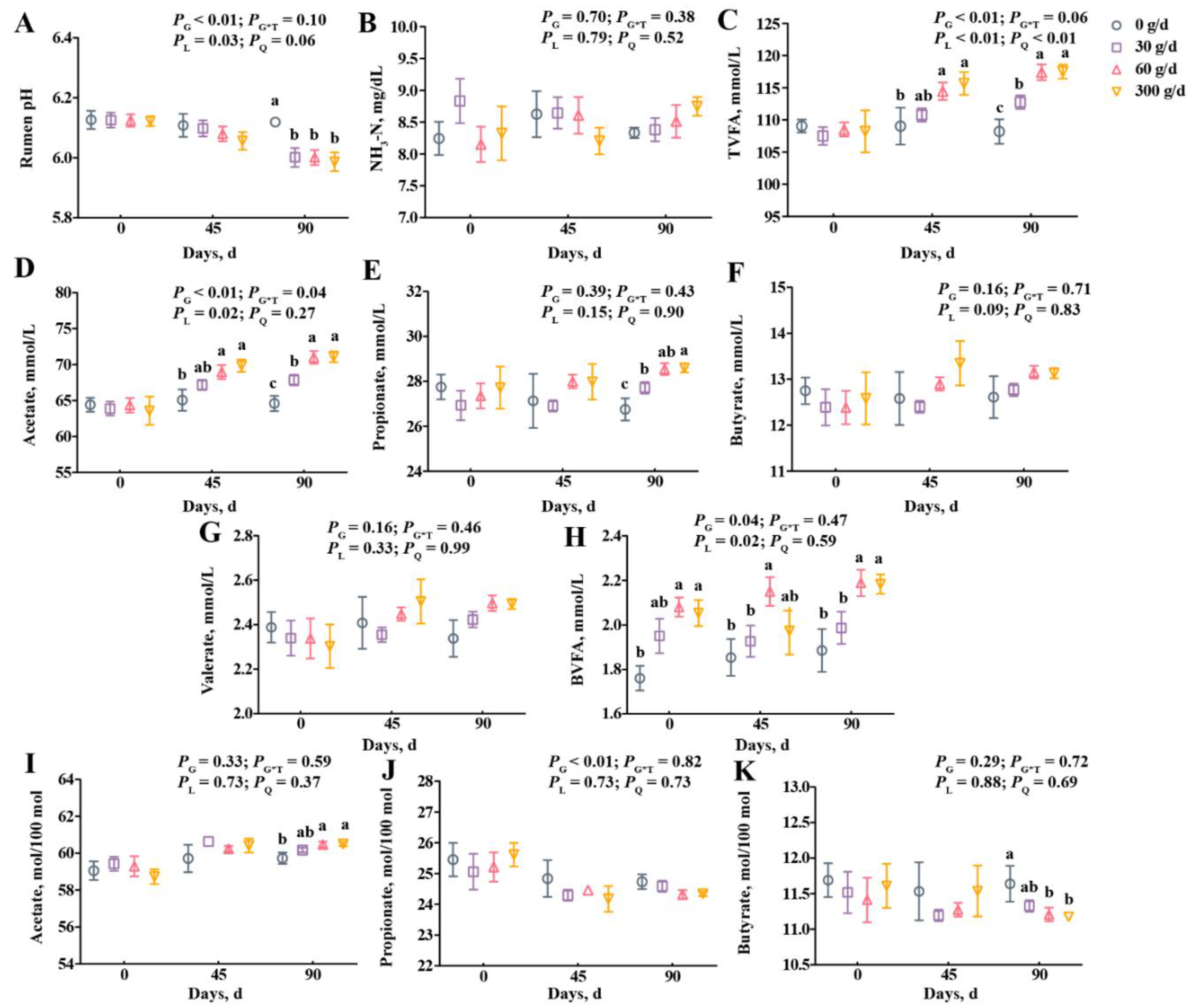


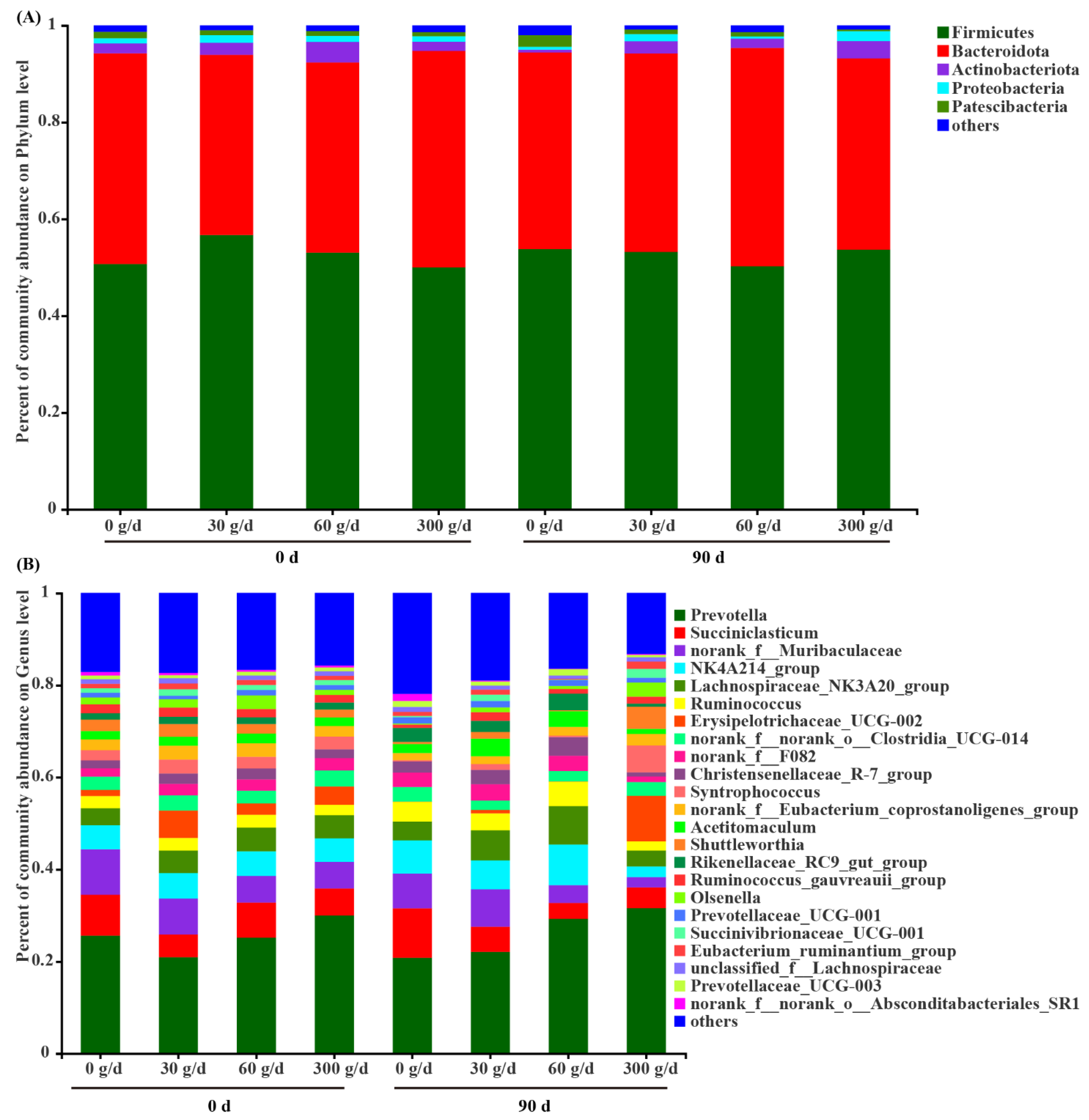
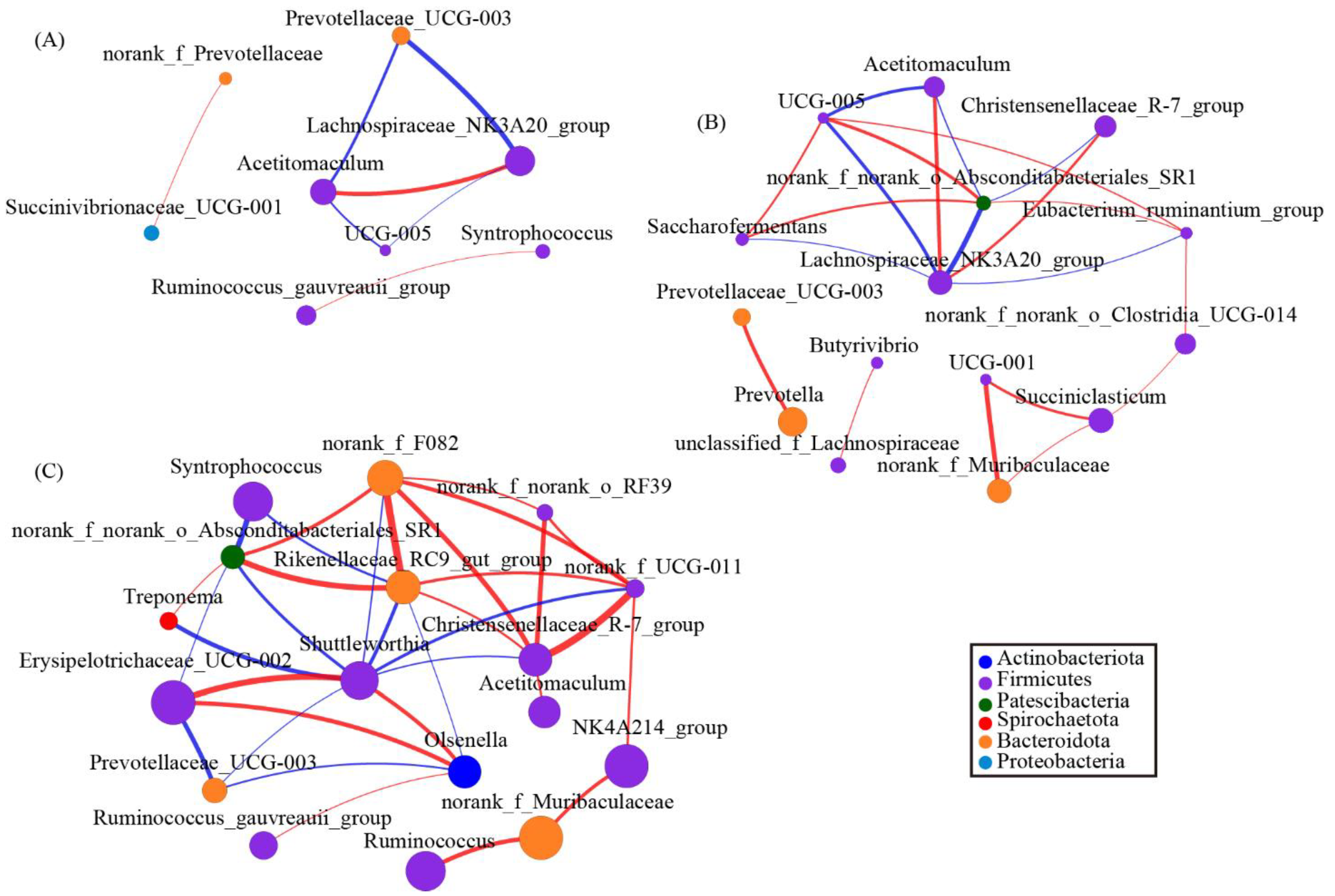
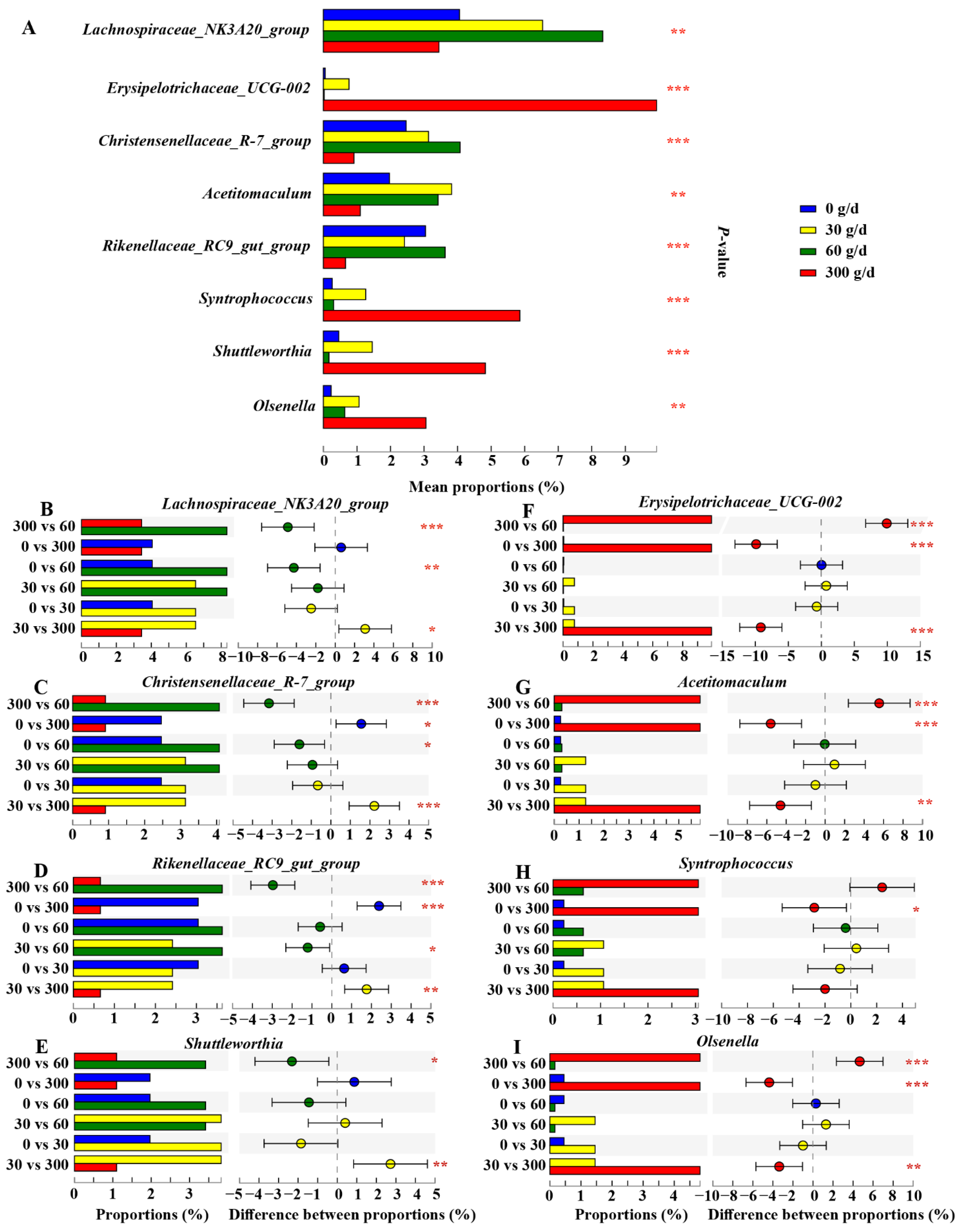
| Items | ATC Supplementation, g/d per Head | SEM | p-Value | ||||||
|---|---|---|---|---|---|---|---|---|---|
| 0 | 30 | 60 | 300 | G | G × T | L | Q | ||
| DMI, kg/d | |||||||||
| Average | 21.70 | 21.95 | 21.91 | 21.87 | 0.103 | 0.36 | 0.56 | 0.71 | 0.66 |
| 0–30 d | 21.93 | 22.01 | 22.16 | 21.84 | 0.182 | 0.17 | |||
| 30–60 d | 21.38 | 21.52 | 21.59 | 21.68 | 0.170 | 0.21 | |||
| 60–90 d | 21.81 b | 22.32 a | 21.97 ab | 22.10 ab | 0.159 | 0.04 | |||
| Feeding frequency, bouts/d | |||||||||
| Average | 20.33 | 20.71 | 21.65 | 21.15 | 0.540 | 0.27 | 0.32 | 0.35 | 0.90 |
| 0–30 d | 19.85 b | 21.28 ab | 22.38 a | 20.28 ab | 0.884 | 0.04 | |||
| 30–60 d | 19.91 | 19.45 | 19.86 | 21.47 | 0.826 | 0.09 | |||
| 60–90 d | 21.24 | 21.41 | 22.70 | 21.70 | 0.769 | 0.22 | |||
| Feeding duration, h/d | |||||||||
| Average | 4.40 a | 3.67 c | 3.57 c | 3.97 b | 0.038 | <0.01 | 0.01 | <0.01 | <0.01 |
| 0–30 d | 4.13 a | 3.56 b | 3.30 c | 3.60 b | 0.068 | <0.01 | |||
| 30–60 d | 4.48 a | 3.64 c | 3.53 c | 3.96 b | 0.064 | <0.01 | |||
| 60–90 d | 4.61 a | 3.80 c | 3.87 c | 4.34 b | 0.059 | <0.01 | |||
| DMI/Feeding frequency, kg/bouts | |||||||||
| Average | 1.08 | 1.07 | 1.03 | 1.04 | 0.026 | 0.37 | 0.32 | 0.50 | 0.83 |
| 0–30 d | 1.13 | 1.05 | 1.02 | 1.10 | 0.043 | 0.06 | |||
| 30–60 d | 1.08 | 1.12 | 1.09 | 1.01 | 0.040 | 0.06 | |||
| 60–90 d | 1.03 | 1.05 | 0.97 | 1.02 | 0.037 | 0.16 | |||
| Feeding duration/Feeding frequency, min/bouts | |||||||||
| Average | 13.07 a | 10.74 b | 10.01 c | 11.35 b | 0.261 | <0.01 | 0.45 | <0.01 | 0.20 |
| 0–30 d | 12.70 a | 10.17 bc | 9.13 c | 10.90 b | 0.464 | <0.01 | |||
| 30–60 d | 13.52 a | 11.32 b | 10.68 b | 11.12 b | 0.434 | <0.01 | |||
| 60–90 d | 12.99 a | 10.73 b | 10.24 b | 12.04 a | 0.404 | <0.01 | |||
| DMI/Feeding duration, kg/h | |||||||||
| Average | 4.94 d | 6.01 b | 6.18 a | 5.55 c | 0.066 | <0.01 | 0.01 | <0.01 | 0.04 |
| 0–30 d | 5.37 c | 6.20 b | 6.73 a | 6.08 b | 0.107 | <0.01 | |||
| 30–60 d | 4.75 c | 5.93 a | 6.12 a | 5.48 b | 0.100 | <0.01 | |||
| 60–90 d | 4.71 c | 5.89 a | 5.70 a | 5.10 b | 0.093 | <0.01 | |||
| Items | ATC Supplementation, g/d per Head | SEM | p-Value | ||||||
|---|---|---|---|---|---|---|---|---|---|
| 0 | 30 | 60 | 300 | G | G × T | L | Q | ||
| Milk yield, kg/d | |||||||||
| Average | 27.33 c | 28.98 b | 30.15 a | 30.35 a | 0.376 | <0.01 | 0.98 | <0.01 | <0.01 |
| 0–30 d | 28.56 b | 29.75 ab | 30.87 a | 31.00 a | 0.918 | 0.01 | |||
| 30–60 d | 27.53 b | 29.28 ab | 30.38 a | 30.57 a | 0.896 | <0.01 | |||
| 60–90 d | 25.90 b | 27.90 a | 29.20 a | 29.49 a | 0.882 | <0.01 | |||
| FCM yield, kg/d | |||||||||
| Average | 32.73 b | 34.95 ab | 36.73 a | 36.95 a | 0.947 | <0.01 | 1.00 | <0.01 | 0.04 |
| 0–30 d | 33.93 | 36.34 | 37.64 | 37.99 | 1.552 | 0.05 | |||
| 30–60 d | 33.30 | 34.98 | 37.22 | 36.95 | 1.451 | 0.06 | |||
| 60–90 d | 30.95 b | 33.52 ab | 35.32 a | 35.92 a | 1.350 | 0.02 | |||
| ECM, kg/d | |||||||||
| Average | 31.36 c | 33.41 b | 34.88 a | 35.18 a | 0.623 | <0.01 | 0.98 | <0.01 | <0.01 |
| 0–30 d | 33.26 | 34.89 | 35.96 | 36.13 | 1.107 | 0.05 | |||
| 30–60 d | 31.38 b | 33.54 ab | 35.46 a | 35.30 a | 1.035 | 0.01 | |||
| 60–90 d | 29.44 b | 31.80 ab | 33.24 a | 34.10 a | 0.963 | <0.01 | |||
| Milk yield/DMI | |||||||||
| Average | 1.26 c | 1.32 b | 1.38 ab | 1.39 a | 0.018 | <0.01 | 0.99 | <0.01 | 0.09 |
| 0–30 d | 1.31 b | 1.35 ab | 1.40 a | 1.42 a | 0.021 | 0.01 | |||
| 30–60 d | 1.29 b | 1.36 ab | 1.41 a | 1.41 a | 0.020 | 0.01 | |||
| 60–90 d | 1.19 b | 1.26 ab | 1.33 a | 1.34 a | 0.017 | <0.01 | |||
| FCM/DMI | |||||||||
| Average | 1.51 b | 1.60 ab | 1.68 a | 1.69 a | 0.037 | 0.01 | 1.00 | 0.02 | 0.17 |
| 0–30 d | 1.55 | 1.65 | 1.70 | 1.74 | 0.073 | 0.06 | |||
| 30–60 d | 1.56 | 1.63 | 1.73 | 1.70 | 0.068 | 0.08 | |||
| 60–90 d | 1.42 | 1.51 | 1.61 | 1.63 | 0.063 | 0.06 | |||
| ECM/DMI | |||||||||
| Average | 1.45 b | 1.53 b | 1.60 a | 1.61 a | 0.032 | <0.01 | 0.98 | <0.01 | 0.07 |
| 0–30 d | 1.52 | 1.59 | 1.63 | 1.66 | 0.053 | 0.05 | |||
| 30–60 d | 1.52 b | 1.56 ab | 1.65 a | 1.66 a | 0.050 | 0.01 | |||
| 60–90 d | 1.35 b | 1.43 ab | 1.52 a | 1.55 a | 0.046 | 0.01 | |||
| Items | ATC Supplementation, g/d per Head | SEM | p-Value | ||||||
|---|---|---|---|---|---|---|---|---|---|
| 0 | 30 | 60 | 300 | G | G × T | L | Q | ||
| Milk protein, % | |||||||||
| Average | 3.81 | 3.83 | 3.82 | 3.83 | 0.064 | 0.99 | 0.80 | 0.48 | 0.37 |
| 0–30 d | 3.98 | 3.93 | 3.88 | 3.86 | 0.105 | 0.37 | |||
| 30–60 d | 3.71 | 3.81 | 3.88 | 3.83 | 0.098 | 0.22 | |||
| 60–90 d | 3.73 | 3.74 | 3.70 | 3.80 | 0.091 | 0.46 | |||
| Milk protein yield, kg/d | |||||||||
| Average | 1.04 b | 1.11 a | 1.15 a | 1.16 a | 0.026 | <0.01 | 0.85 | <0.01 | <0.01 |
| 0–30 d | 1.14 | 1.17 | 1.20 | 1.20 | 0.042 | 0.30 | |||
| 30–60 d | 1.02 b | 1.12 ab | 1.18 a | 1.17 a | 0.039 | 0.01 | |||
| 60–90 d | 0.97 b | 1.04 ab | 1.08 a | 1.13 a | 0.037 | 0.01 | |||
| Milk fat, % | |||||||||
| Average | 4.73 | 4.77 | 4.83 | 4.84 | 0.152 | 0.94 | 1.00 | 0.88 | 0.99 |
| 0–30 d | 4.68 | 4.87 | 4.85 | 4.91 | 0.270 | 0.51 | |||
| 30–60 d | 4.79 | 4.70 | 4.86 | 4.77 | 0.253 | 0.65 | |||
| 60–90 d | 4.71 | 4.74 | 4.79 | 4.85 | 0.235 | 0.69 | |||
| Milk fat yield, kg/d | |||||||||
| Average | 1.29 b | 1.38 ab | 1.46 a | 1.47 a | 0.053 | 0.04 | 1.00 | 0.03 | 0.15 |
| 0–30 d | 1.33 | 1.45 | 1.50 | 1.52 | 0.087 | 0.11 | |||
| 30–60 d | 1.32 | 1.38 | 1.48 | 1.46 | 0.081 | 0.16 | |||
| 60–90 d | 1.22 | 1.32 | 1.40 | 1.43 | 0.076 | 0.07 | |||
| Milk lactose, % | |||||||||
| Average | 5.08 | 5.09 | 5.04 | 5.06 | 0.034 | 0.73 | 0.95 | 0.18 | 0.45 |
| 0–30 d | 5.15 | 5.12 | 5.08 | 5.10 | 0.060 | 0.41 | |||
| 30–60 d | 4.99 | 5.05 | 5.02 | 5.03 | 0.056 | 0.48 | |||
| 60–90 d | 5.09 | 5.09 | 5.01 | 5.04 | 0.052 | 0.29 | |||
| Milk lactose yield, kg/d | |||||||||
| Average | 1.39 c | 1.48 b | 1.52 ab | 1.54 a | 0.02 | <0.01 | <0.01 | <0.01 | 0.04 |
| 0–30 d | 1.47 b | 1.52 ab | 1.57 a | 1.58 a | 0.03 | 0.02 | |||
| 30–60 d | 1.38 b | 1.48 a | 1.52 a | 1.54 a | 0.03 | <0.01 | |||
| 60–90 d | 1.32 b | 1.42 a | 1.46 a | 1.49 a | 0.03 | <0.01 | |||
| Milk urea nitrogen, mg/dL | |||||||||
| Average | 17.23 | 16.70 | 17.13 | 18.18 | 0.715 | 0.49 | 0.95 | 0.84 | 0.74 |
| 0–30 d | 14.76 | 14.26 | 15.33 | 17.07 | 1.105 | 0.10 | |||
| 30–60 d | 16.32 | 15.29 | 15.70 | 16.10 | 1.270 | 0.56 | |||
| 60–90 d | 20.61 | 20.56 | 20.37 | 21.38 | 1.105 | 0.54 | |||
| SCC, ×1000/mL | |||||||||
| Average | 68.06 a | 52.23 b | 47.90 bc | 43.68 c | 2.705 | <0.01 | 0.42 | <0.01 | <0.01 |
| 0–30 d | 67.23 a | 58.60 ab | 52.98 bc | 41.85 c | 4.809 | <0.01 | |||
| 30–60 d | 70.73 a | 44.73 b | 44.64 b | 45.25 b | 4.496 | <0.01 | |||
| 60–90 d | 66.23 a | 53.35 ab | 46.09 b | 43.96 b | 4.182 | <0.01 | |||
Publisher’s Note: MDPI stays neutral with regard to jurisdictional claims in published maps and institutional affiliations. |
© 2022 by the authors. Licensee MDPI, Basel, Switzerland. This article is an open access article distributed under the terms and conditions of the Creative Commons Attribution (CC BY) license (https://creativecommons.org/licenses/by/4.0/).
Share and Cite
Kong, F.; Zhang, Y.; Wang, S.; Cao, Z.; Liu, Y.; Zhang, Z.; Wang, W.; Lu, N.; Li, S. Acremonium terricola Culture’s Dose–Response Effects on Lactational Performance, Antioxidant Capacity, and Ruminal Characteristics in Holstein Dairy Cows. Antioxidants 2022, 11, 175. https://doi.org/10.3390/antiox11010175
Kong F, Zhang Y, Wang S, Cao Z, Liu Y, Zhang Z, Wang W, Lu N, Li S. Acremonium terricola Culture’s Dose–Response Effects on Lactational Performance, Antioxidant Capacity, and Ruminal Characteristics in Holstein Dairy Cows. Antioxidants. 2022; 11(1):175. https://doi.org/10.3390/antiox11010175
Chicago/Turabian StyleKong, Fanlin, Yijia Zhang, Shuo Wang, Zan Cao, Yanfang Liu, Zixiao Zhang, Wei Wang, Na Lu, and Shengli Li. 2022. "Acremonium terricola Culture’s Dose–Response Effects on Lactational Performance, Antioxidant Capacity, and Ruminal Characteristics in Holstein Dairy Cows" Antioxidants 11, no. 1: 175. https://doi.org/10.3390/antiox11010175
APA StyleKong, F., Zhang, Y., Wang, S., Cao, Z., Liu, Y., Zhang, Z., Wang, W., Lu, N., & Li, S. (2022). Acremonium terricola Culture’s Dose–Response Effects on Lactational Performance, Antioxidant Capacity, and Ruminal Characteristics in Holstein Dairy Cows. Antioxidants, 11(1), 175. https://doi.org/10.3390/antiox11010175





